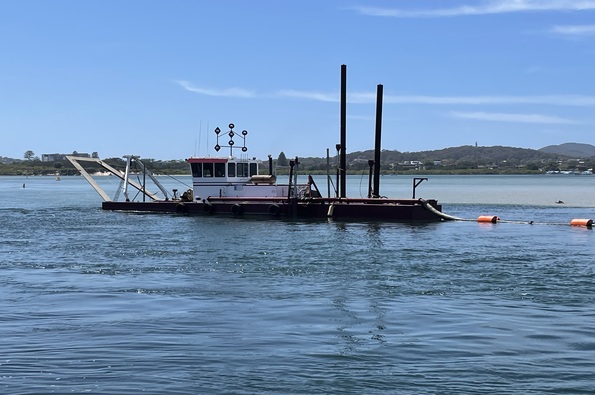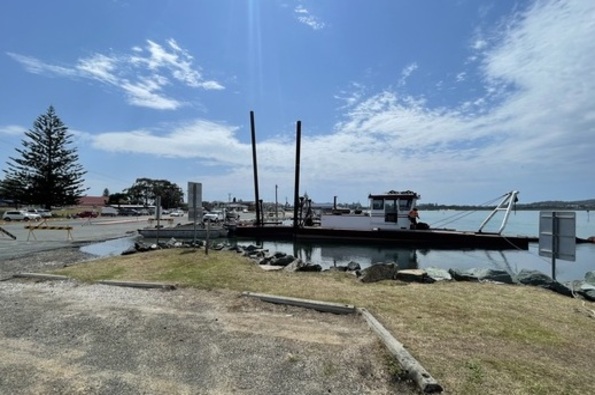Delayed NSW maintenance dredging completed to boost local economy
Not a member yet? Learn about the benefits of membership

Dredging Solution’s cutter suction dredger [Credit] MidCoast Council
Despite ongoing controversy in some quarters of Wallis Lake’s user community about how best to prioritise the allocation of limited public funds, the long-anticipated maintenance dredging at the Point Road Boat Ramp, Tuncurry, New South Wales (NSW), was completed in mid-December 2023, after an 18-month delay.
The boat ramp facilitates public and commercial access to Wallis Lake and is listed in the top 5% of ramps in NSW based on user numbers. However, like the rest of Wallis Lake, the stretch of water from the boat ramp downstream to an area known locally as ‘The Tuncurry Channel’ is adversely affected by sand shoaling.
‘A jewel in the crown’
With a surface area of 99 square kilometres, Wallis Lake is an open and trained wave-dominated barrier estuary. It receives water from several inflowing rivers and streams and flows into the Tasman Sea between the towns of Forster and Tuncurry on the mid-north coast of NSW. The ‘aqua blue waterway’ has long held public interest and former acting NSW Maritime Executive Director Hendrik Clasie identified it in early 2023 as a key investment location in NSW’s Maritime Infrastructure Plan and the Coastal Dredging Strategy 2019-2024.
Home to marine and brackish, subtidal, intertidal and supratidal estuarine habitats, Wallis Lake supports one-fifth of the total seagrasses in NSW, and its extensive saltmarsh and mangrove communities are considered nationally important. The lake is also integral to the local economy: it produces 80% of the state’s commercial crabs, is one of Australia’s most significant producers of Sydney rock oysters, and during the summer, the Tuncurry-Forster area of Wallis Lake is also a popular tourist destination.
The now-completed dredging works were finalised in time to ensure the local oyster industry and other businesses dependent on the waterway could capitalise on the influx of tourists during the 2023 Christmas season. Tanya Thompson, member of the NSW Legislative Assembly for Myall Lakes, hailed the operation as a significant milestone in the ongoing efforts to enhance waterway access and maintain the vitality of the local maritime economy.
Delays and resolutions
Sand accumulation means the boat ramp and channel require regular maintenance dredging to remain navigable, but the project had been beset with a series of delays. Talking to CEDA Industry News (CIN), an MCC spokesperson explained that the usual cycle of maintenance dredging was delayed “as a result of two other higher priority dredging projects that took place in 2019 and 2021 in the Manning River”.
“The project was [then] held up for [a further] 18 months from early 2022 due to licensing issues”, continued the spokesperson. While supported by most stakeholders, the spokesperson also noted objections from “a small section of the local community [who felt] that dredging should be carried out in other areas of Wallis Lake.” Collectively, these delays highlight some of the potential challenges of the dredging licence application and funding processes.
To address the sometimes divergent needs of multiple levels of government, industry groups and local communities, those wishing to undertake dredging works in NSW must navigate a complex governance process before doing so.
Local councils, in this case, MCC, are responsible for undertaking the Environmental Impact Assessment (EIA) for such works, and several State Government Departments appraise each dredging project before issuing a licence to the council. These wide-ranging assessments and associated public consultations often delay the approval and funding process, as regulators must consider conflicting priorities and opinions. The Point Road Boat Ramp licence application was a case in point, but collaboration between the NSW Government, MCC and the local community ultimately proved successful.

The Point Road Boat Ramp [Credit] MidCoast Council
Let dredging commence
The Point Road Boat Ramp dredging works were funded jointly by a grant issued under Transport for NSW’s (TfNSW) Boating Access Dredging Program - launched in March 2021 with an allocation of $2 million (AUS) for dredging projects in priority regional locations - and the MidCoast Council (MCC). Project planning and delivery was coordinated by TfNSW’s Maritime Infrastructure Delivery Office (MIDO), in collaboration with the MCC and other local stakeholders, and it monitored performance and compliance from mobilisation until the completion of the boat ramp dredging works.
On securing the dredging licence and funding, MCC awarded the dredging contract to the NSW-based company Dredging Solutions. Of the dredging licence’s multiple (standard) conditions, water quality (turbidity) was the primary environmental focus. The MCC spokesperson told CIN that to mitigate potential habitat damage, the EIA “required visual monitoring and sampling [to] be undertaken by the contractor to ensure no turbid plumes spread beyond 50m of the dredge site.” The spokesperson also told CIN that “strict erosion and sediment control measures were put in place” at the temporary deposition site at Vincent Fazio Park, Tuncurry. Site preparation commenced at the end of October 2023 as part of the dredging mobilisation phase and took one week to complete.
Outlining the subsequent four-week dredging operation, the MCC spokesperson confirmed that the contractor used an 8’/6” 350hp cutter suction dredger for the project and that: “The dredge spoil was pumped via dredge pipeline to [the] council reserve adjacent to the channel where it was [temporarily stockpiled] de-watered, dried and then transported off-site [by truck] for re-use as development fill.”
The final volume of dredged material was larger than that anticipated when the project got underway. Previous delays had led to excessive sand accumulation within the channel south of the Forster-Tuncurry Bridge and, as a result, the scope of dredging works covered a larger area than previous campaigns in this section of Wallis Lake. The pre-dredge press release published on 26 October 2023, forecast the removal of 17,000 cubic metres of marine sediment to improve navigability for waterway users. Even this figure was conservative and the MCC spokesperson told CIN that by the end of the project, “19,200 cubic metres of marine sediment were dredged from the bed … to maintain public and commercial access to Wallis Lake.”
Benefitting from favourable conditions, Dredging Solutions’ completed the works on schedule, despite the increased volume of dredged material.
The end of the beginning
The successful dredging works at the Point Road Boat Ramp marked the culmination of the first stage to address the wider sand shoaling and safe navigation issues within Wallis Lake.
To ensure it can realise its potential, stakeholders must continue to review the results of a hydrodynamic study undertaken in Q1 of 2023. Identifying short and long-term dredging solutions is vital to improving navigation near the entrance of Wallis Lake estuary and helping to prevent the smothering of oyster leases caused by sand shoaling.
The dredging works did not clear the main channel, and further maintenance dredging works are scheduled for late summer-autumn 2024.
While the advice given in this editorial content has been developed using the best information available, it is intended purely as guidance to be used at the user’s own risk. No responsibility is accepted by CEDA or by the Intent Communications Ltd or by any person, firm, corporation or organisation who or which has been in any way concerned with the furnishing of information or data, the compilation, publication or any translation, supply or sale of this Guidance for the accuracy of any information or advice given herein or for any omission herefrom or from any consequences whatsoever resulting directly or indirectly from compliance with or adoption of guidance contained therein even if caused by a failure to exercise reasonable care.